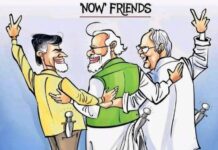The recent glut of desi thrillers still doesn’t answer why they don’t sell nearly as much as the foreign ones. Do we still prefer our murders set in alien places?
It’s a hectic winter. Having taught workshops in Delhi, Mumbai, Bengaluru and other cities over the past years, I was in Puducherry the other week to speak to a group of 15 or so aspiring authors about how to write thrillers. At the same time, I was gearing up for a tour — as I, in the coming months, would be speaking on the subject of thrillers at literary festivals across the country.
Suddenly I was struck by a thought: Why is this genre, which was once seen as literary weed or mental manure at the best, and was a decade ago far from the radar of the publishing industry or the writerly community, suddenly arousing so much excitement?
Indian cult objects
As I stood there barefoot on the red-oxide floor of the rustic classroom in Auroville, explaining the charts and arrows I’d been drawing on the whiteboard, looking at the students — who had come from all over the country — in the eye, it occurred to me that what I had there before me might well be the new face (as well as phase) of bestseller fiction. Could it be possible that I was looking at the future of Indian literature?
Teaching writing, I’m never quite sure what students make of all my scenarios for heightening tension and mechanisms to create suspense, but one point I try to reinforce time and again is that any Indian setting, no matter how mundane or rural, especially if other than the usual suspects (Mumbai, Delhi and Kolkata), will be of great novelty value for any fan of mystery and suspense fiction. A natural new cause for thrills and chills.
But all these years we’ve been reading foreign thrillers with gusto and I think we have become brainwashed by their format and style. Until not so long ago, the detective stories of Sherlock Holmes and Agatha Christie were virtually the only ones on the bookshop shelves, despite the fact that India itself can be such an exciting component in mysterious tales, something Western writers noticed as far back as the Victorian era.
The Adventure of the Speckled Band (1892) — the author Conan Doyle’s own favourite Sherlock Holmes’ story — featured as its murder weapon an extremely deadly Bengali swamp-adder trained to kill. Although rather unscientific (Bengal never exported swamp-adders to be used by Western murderers simply because there are none there) the corrupting influences of colonialism loomed large in that short story and the culprit, if you recall, turned out to be a Calcutta-returned brutish Englishman, a self-taught snake-charmer.
Earlier, Wilkie Collins had thrown in the theft of an Indian cult object in what is considered to be the world’s first proper crime novel, The Moonstone (1868), not to mention three mysterious Brahmins posing as juggling gypsies trying to retrieve it from foggy Yorkshire. Collins thereby inaugurated a fashionable popular culture theme in Western fiction which spilled over into twentieth-century B-grade cinema: the sacred but cursed Indian jewel, as well as the secret Oriental society. Even big players like Steven Spielberg (Indiana Jones and the Temple of Doom), the James Bond franchise (Octopussy) and the Beatles (Help!) contributed to that nowadays, thankfully, largely obsolete trend.
The motif of purloined Indian jewels featured in two of Agatha Christie’s plots — The Secret of Chimneys and The Rajah’s Emerald — but to her credit she tried out an innovative murder weapon in The Big Four: a toxic chicken curry, presumably because the spiciness hid the taste of poison.
However, once I myself had settled down here in India, shallow exotica didn’t really satisfy me. For decades I kept browsing in the bookshops of Bengaluru for more authentic fare. Unfortunately, sub-continental thrillers, when the genre was in its infancy, were for the longest time stuck in the rutted tracks that Western pulp had made: the local fictional detectives — if we, for example, look at Sharadindu Bandyopadhyay’s eternally popular ‘Byomkesh Bakshi’, Ibn-e Safi’s ‘Imran series’ (that was being rediscovered through fresh translations) and Kalpana Swaminathan’s more contemporary ‘Lalli’— were spoofy xeroxes of Sherlock Holmes, Nick Carter and Miss Marple. Besides, their books barely depicted the places they were set in.
Pulpy gems
Just as in Victorian pulp fiction, where the Indian element was merely a cheap trope, these ink slingers too had seemingly forgotten that the hallmark of a proper detective story is to evoke dark milieus like, to take a well-known example, the mean streets of Los Angeles, in the case of Raymond Chandler’s classic noir, or somewhat more recently, the bestselling LA Quartet by James Ellroy.
Only the rare writer, such as Ashok Banker with his pioneering trilogy published in the early 1990s — The Iron Bra, Murder & Champagne, and Three Dead Admen — seemed to consider his own country an interesting setting to write creatively about.
I still recall that lucky day when I found The Iron Bra in a bookshop in Patna and read it on a train ride: a thoroughly gory story of a Konkani female investigator, Sheila Ray, whose finger rests lightly on the trigger as she takes on the city’s gangsters. Above all, the growing Mumbai’s construction sites were a crucial component in the tight plot — as was the entire city (then, of course, called Bombay). Banker’s books were pulpy gems that suggested to me that the desi thriller could be something that the serious-minded author might sully his fingers with. Unfortunately, he didn’t get his due and Banker moved on to more lucrative things such as television writing and mythological retellings.
Meanwhile, Western paperback writers were happily exploiting all the world’s exciting locales: H.R.F. Keating imagined an Inspector Ganesh V. Ghote in Bombay, Alexander McCall Smith made Botswana into a bestseller (The No. 1 Ladies Detective Agency series) while John Burdett dug into Thailand’s seamier sides in his Bangkok series.
At the same time, writers in my native Sweden were mining their own country for fictional crime scenes. Tourism peaked in Henning Mankell’s rather uninteresting home town Ystad as his ‘Wallander’ police procedurals sold 40 million copies, as it did in Fjällbacka after Camilla Läckberg’s rural mysteries sold 20 million copies globally. (Ironically enough, the latter are about a village of some 850 people, so I can’t quite get my head around how all those murderers in her books haven’t been able to decimate the entire population.)
Stockholm capitalized big time on Stieg Larsson’s Millennium trilogy that has, by now, sold over 80 million copies and spawned posthumous sequels as well as Hollywood movies. Tourists can nowadays do the official ‘Millennium Walk’ in order to see all the main locations. The obvious conclusion to draw here is that every town, including the smallest village, is worthy of its own detective series — and can benefit from it!
Of course, the genre has ancient — and quite imposing — roots in the West. Its hoary origins are traced back to proto-crime writers like Sophocles, a Greek who in circa 406 BCE penned the drama Oedipus the King: a twisted murder mystery with multiple rather sleazy and horrific elements in it.
If we merely consider the plotline of a popular English play such as Hamlet (c 1603), even William Shakespeare wrote what can be labeled ‘Nordic noir’: some dude returns home to Denmark to find his father dead. He tries to figure out what happened. Turns out daddy got whacked by his closest family members. Bloodbath follows.
The aforementioned Henning Mankell, who also worked in theatre in Sweden, once pointed out to me that modern crime fiction is, just like the ancient dramas were in their day, a great mirror through which to view our world. That conversation led me to think that thrillers have a cathartic function, just like ancient drama and modern masala films have had. They set the score straight by having, after much bad stuff, the good guys do the good stuff at the climactic end.
Minor boom
In India, the genre was boosted by the appearance of a truly great novel that was at the same time an epic story about gangsters and policemen. Vikram Chandra’s Sacred Games (2006) clocked in at 900 pages and provided us with a magnificent portrayal of Mumbai’s underworld as well as its upper crust. In terms of reading value, it was worth at least 10 regular books, crammed as it was with stories within stories taking the reader through post-Partition blues, the history of Indian espionage, or even how to write a Bollywood action movie screenplay.
Then five years went by and nothing fun happened. But suddenly in the early 2010s came what seemed like a minor boom. Two taut thrillers set in New Delhi excited me: Somnath Batabyal’s tale of corruption in journalism which took readers on a tour of the capital city after dark, The Price You Pay (2011), followed by Mukul Deva’s absolutely sparkling The Dust Will Never Settle (2012). These convinced me that something must be cooking. In the former, a rookie journo finds himself deeply mixed up with the reality behind the stories he is filing.
The latter I would rank as the best work so far by the grandmaster of Indian military action fiction, Deva, who has been variously compared to Robert Ludlum, Alistair MacLean and Frederick Forsyth. As in his earlier books it featured a terrorist plot, but this time the drama was complicated by the protagonist and antagonist being father and daughter, as Delhi top cop Ravinder Singh Gill begins to worry that his little Ruby is planning to blow up the national capital. It was truly cathartic reading!
The following year yet another fabulous genre novel appeared, Shatrujeet Nath’s The Karachi Deception (2013), which took readers on a danger-packed excursion into Pakistan. I don’t know if the author went there to research the book or not, but the political undercurrents of the troubled relations between India and its neighbour play a thrilling role in it.
Finally, as a fifth example, I’d like to mention The Girl From Nongrim Hills (2013) by Ankush Saikia, who genuinely pioneered the use of the Indian small town as a milieu for good guys and bad guys. Thrills apart, the story’s main strength really is its setting — the atmosphere of Shillong is depicted in a way that goes deeper than the picture-postcard narratives of India’s colorful corners.
Simultaneously, there were valiant attempts by the Chennai publishing house Blaft to translate Tamil and Hindi pulp classics into English. What strikes me as significant about this new generation of writers and publishers is that their vision of India is much more nuanced and far better informed than in earlier genre fiction.
Despite their qualities, there were no massive bestsellers — at least none entered the million-copy sales category: it is said that not even the highly hyped Sacred Games earned back the huge royalty advance that publishers had shelled out for it. But its small-screen adaptation is upcoming on Netflix, I hear, starring Saif Ali Khan as the just a wee bit crooked cop protagonist, so maybe sales will pick up then.
Which makes me wonder why desi thrillers don’t sell and how come we still prefer foreign stories about alien places? The flavor of the season appears to be cool as sushi Japanese writers such as Keigo Higashino, Natsuo Kirino, Fuminori Nakamura, Kanae Minato and Hideo Yokoyama whose psychological potboilers are well on their way to crowd out the Scandinavian social realist pulp in Indian bookshops.
Cusp of change
Mita Kapur, one of India’s leading literary agents and the criminal mind behind the Noir Literature Festival in Delhi, which started in 2015, reveals that this year’s edition stands canceled and its future is uncertain. She doesn’t see that thriller writing has dislodged the quest for ‘the Great Indian Novel’, but what is hot now is actually non-fiction. Yet she does admit that her agency is being flooded with thriller manuscripts: “There is a veritable increase in the number of submissions — one in every four books is a thriller or a detective or crime fiction. We’ve signed on three crime writers in 2017. Surprisingly, a lot of professionals are turning to thriller writing.”
So despite all, maybe we are approaching the cusp of change? One reason for the so-so sales of domestic whodunits could perhaps be that apart from the occasional gem of an absorbing mystery, local writers have quite often (with the exception of those who take the genre seriously) penned speculative, hastily written, poorly thought-out quickies for the growing metropolitan paperback market, with barely existent plotting, little sense of stylistics, and lack of authenticity due to a by and large upper-class take on the social scenario.
Besides, India as a setting presents certain challenges — one may even call them traps. Some writers overload their stories with cultural stereotypes and cardamom-flavored exotica pandering to a prospective Western audience instead of sidestepping the clichés by giving the over-familiar a fresh twist. What would constitute an Indian thriller style then? If we think about it, there’s a solid template already in place — popular cinema which, via its roots in theatre, draws on the Natya Shastra authored by Bharata Muni centuries some 1,500 years ago. A good drama, said the sage of hoary yore, should include dance and music, emotions or bhavas such as comedy (hasya), terror (bhayanaka), heroism (vira) and naturally also love (rati), and all the other ingredients that cinema still thrives on. So why not spice up desi thrillers with some Bollywood-style masala?
Writing well is a craft and creative writing workshops, that have started proliferating, could be a reasonable investment in a publishing economy impatient to reap its rewards. When Raymond Chandler decided to give crime writing a shot, he enrolled in a course called ‘Short Story Writing 52AB.’ He debuted in a pulp magazine in 1933 and became, a decade later, one of the biggest writers in Hollywood.
Chandler may have succeeded even without those classes, but in a competitive market like the entertainment industry, he cannot be faulted for having done that bit of preparation — think of it like a carpenter taking woodworking classes before building a cupboard in which to hide away skeletons. Perhaps the growing interest in taking writing workshops in India is a sign that things are moving in the right direction? #KhabarLive #hydnews







